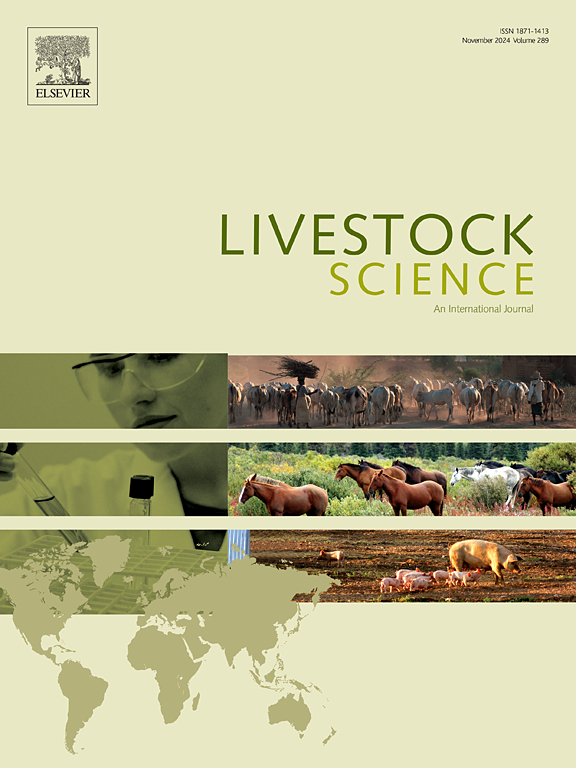Faecal microbial profiles of Angus beef cattle with divergent immune responses
IF 1.9
3区 农林科学
Q2 AGRICULTURE, DAIRY & ANIMAL SCIENCE
引用次数: 0
Abstract
Microorganisms inhabiting the gut (gut microbiota) have been shown to influence host immune responsiveness in a variety of species including cattle. The ability of cattle to cope with disease challenges is economically important to the beef industry, for example, disease associated costs in Australia are estimated to reach almost $1 billion Australian dollars (AUD) per annum. Therefore, the aim of this study was to characterise faecal microbiota of beef cattle at weaning and to investigate its association with immune response phenotypes assessed at the same time. Faecal samples were obtained from Angus cattle, phenotyped for cell-mediated and antibody-mediated immune responses at weaning. Immune response phenotypes, as well as an immune index score, were calculated and animals ranked to identify high, medium, and low immune response cohorts (n = 20/cohort). 16S rRNA gene sequence data was used to infer relative abundances and alpha and beta diversity metrics of microbial profiles. Further statistical testing involved a multivariate analysis of variance (MANOVA) to identify individual microbiota whose abundance significantly differed between the high, medium, and low cohorts for each of the immune response phenotypes. Moreover, a regression analysis was undertaken to determine significant associations between phyla or genera and immune response phenotype. A total of six phyla and three genera were found to significantly differ in relative abundances and six phyla and two genera were significantly associated with at least one of the immune response phenotypes. Notably, Bacteroidota, Euryarchaeota, and Proteobacteria may be biologically relevant due to their relationship with gut health and disease. The limitation of the current study was only conducting faecal matter sampling and subsequent immune response phenotyping at weaning stage. Future efforts should be made to explore whether the number of significant differences in faecal microbial profiles increase at a later stage.
免疫反应差异的安格斯肉牛粪便微生物谱
在包括牛在内的多种物种中,肠道微生物(肠道微生物群)已被证明影响宿主的免疫反应。牛应对疾病挑战的能力对牛肉产业具有重要的经济意义,例如,澳大利亚的疾病相关成本估计每年达到近10亿澳元(AUD)。因此,本研究的目的是表征断奶肉牛的粪便微生物群,并同时评估其与免疫反应表型的关系。取安格斯牛的粪便样本,对断奶时细胞介导和抗体介导的免疫反应进行表型分析。计算免疫反应表型以及免疫指数评分,并对动物进行排序,以确定高、中、低免疫反应队列(n = 20/队列)。16S rRNA基因序列数据用于推断微生物剖面的相对丰度和α和β多样性指标。进一步的统计检验包括多变量方差分析(MANOVA),以确定每个免疫反应表型的高、中、低队列中丰度显著差异的单个微生物群。此外,还进行了回归分析,以确定门或属与免疫反应表型之间的显著关联。共有6个门和3个属在相对丰度上存在显著差异,6个门和2个属与至少一种免疫应答表型显著相关。值得注意的是,拟杆菌门、Euryarchaeota和变形菌门可能与肠道健康和疾病有生物学相关性。目前研究的局限性是仅在断奶期进行粪便取样和随后的免疫反应表型分析。未来应努力探索粪便微生物谱中显著差异的数量是否在后期增加。
本文章由计算机程序翻译,如有差异,请以英文原文为准。
求助全文
约1分钟内获得全文
求助全文
来源期刊

Livestock Science
农林科学-奶制品与动物科学
CiteScore
4.30
自引率
5.60%
发文量
237
审稿时长
3 months
期刊介绍:
Livestock Science promotes the sound development of the livestock sector by publishing original, peer-reviewed research and review articles covering all aspects of this broad field. The journal welcomes submissions on the avant-garde areas of animal genetics, breeding, growth, reproduction, nutrition, physiology, and behaviour in addition to genetic resources, welfare, ethics, health, management and production systems. The high-quality content of this journal reflects the truly international nature of this broad area of research.
 求助内容:
求助内容: 应助结果提醒方式:
应助结果提醒方式:


